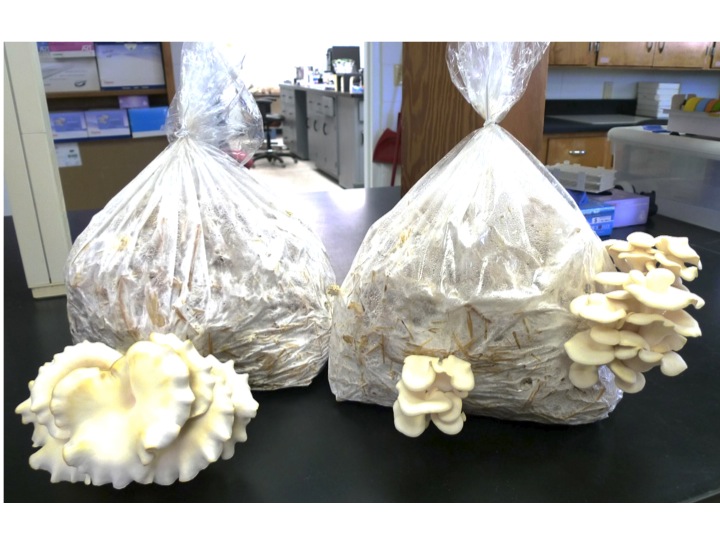
Following basic instructions, grow oyster mushrooms using sterilized straw, a plastic bag, oyster mushroom spawn, and water. Photo by Sunny Liao.
Oyster mushrooms (Pleurotus ostreatus) – which have nothing to do with oysters besides their similar shape – are some of the most delicate, subtlety flavored, and easiest to prepare mushrooms of the culinary world.
They can easily be fried, stir-fried, or braised within a matter of minutes in broths, vinegar, wines, and sauces; or added to soups, stuffed, or mixed with chopped garlic. Other mushrooms, such as shiitake, are sturdier and impart a meatier flavor and texture to a dish. Oyster mushrooms, especially those lighter in color, pair well with seafood or a white meat. Highly perishable, you will want to freeze oyster mushrooms after sautéing with butter or oil to preserve, or dehydrate them to enjoy at a later date.
In addition to being an easy mushroom to prepare, oyster mushrooms are a great source of fiber, protein, and many vitamins and minerals, as well as an excellent source of the antioxidant ergothioneine.
Oyster mushrooms can come in many shades, from cream-colored, to gray, golden, tan, and brown. Their white colored gills, when present, extend from beneath the cap down to their very short stems. They are often described as smelling slightly like licorice and can grow up to about nine inches, but are best consumed young when tender and mild.
Oyster mushrooms grow in many subtropical and temperate environments, commonly found in nature growing in layers, decomposing the wood of dying hardwood trees. This decomposition benefits the ecosystem, as the mushrooms return nutrients and minerals back into the soil.
Interestingly, oyster mushrooms are one of the few known carnivorous mushrooms. The mycelia of the fungi can consume and digest nematodes, which is how it is thought the oyster mushrooms acquire nitrogen.
Arguably one of the best qualities of oyster mushrooms are the ease to which they can be cultivated at home. Using sterilized straw, a plastic bag, oyster mushroom spawn, water, and following basic instructions, oyster mushroom can be produced in as little as two weeks!
You can learn all about oyster mushroom production on the Penn State Extension page: Cultivation of Oyster Mushrooms (http://extension.psu.edu/plants/vegetable-fruit/mushrooms/publications/guides/cultivation-of-oyster-mushrooms).
Once you have the materials gathered, follow this guide, developed by UF/IFAS Suwannee County Extension, to prepare oyster mushrooms bags at home: Preparation of Oyster Mushroom Bags (http://suwannee.ifas.ufl.edu/documents/PREPARATIONOFOYSTERMUSHROOMBAGS.2012.pdf).
As well as being healthy and delicious, oyster mushroom cultivation is fun, and just needs a small amount of space and effort!
- Dung Beetles of the Florida Panhandle - June 26, 2025
- Summer Veggies That Can Take The Heat - May 15, 2025
- Stopping Tomato Blossom-End Rot Before It Starts - April 3, 2025
